Antibody data
- Antibody Data
- Antigen structure
- References [1]
- Comments [0]
- Validations
- Immunocytochemistry [2]
- Immunohistochemistry [1]
- Flow cytometry [2]
- Other assay [1]
Submit
Validation data
Reference
Comment
Report error
- Product number
- MA5-15597 - Provider product page

- Provider
- Invitrogen Antibodies
- Product name
- GSK3B Monoclonal Antibody (3D10)
- Antibody type
- Monoclonal
- Antigen
- Purifed from natural sources
- Description
- MA5-15597 targets GSK3B in indirect ELISA, FACS, IF, IHC, and WB applications and shows reactivity with Human, mouse, Non-human primate, and Rat samples. The MA5-15597 immunogen is purified recombinant fragment of human GSK3B expressed in E. Coli.. MA5-15597 detects GSK3B which has a predicted molecular weight of approximately 46kDa.
- Reactivity
- Human, Mouse, Rat
- Host
- Mouse
- Isotype
- IgG
- Antibody clone number
- 3D10
- Vial size
- 100 μL
- Concentration
- concentration not determined
- Storage
- Store at 4°C short term. For long term storage, store at -20°C, avoiding freeze/thaw cycles.
Submitted references Proteomic characterization of post-mortem human brain tissue following ultracentrifugation-based subcellular fractionation.
Kandigian SE, Ethier EC, Kitchen RR, Lam TT, Arnold SE, Carlyle BC
Brain communications 2022;4(3):fcac103
Brain communications 2022;4(3):fcac103
No comments: Submit comment
Supportive validation
- Submitted by
- Invitrogen Antibodies (provider)
- Main image
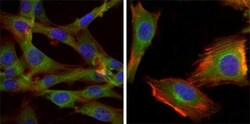
- Experimental details
- Immunofluorescence analysis of NIH/3T3 (left) and U251 (right) cells using GSK3B monoclonal antibody (Product # MA5-15597) (Green). Blue: DRAQ5 fluorescent DNA dye. Red: actin filaments have been labeled with phalloidin.
- Submitted by
- Invitrogen Antibodies (provider)
- Main image
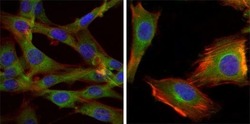
- Experimental details
- Immunofluorescence analysis of NIH/3T3 (left) and U251 (right) cells using GSK3B monoclonal antibody (Product # MA5-15597) (Green). Blue: DRAQ5 fluorescent DNA dye. Red: actin filaments have been labeled with phalloidin.
Supportive validation
- Submitted by
- Invitrogen Antibodies (provider)
- Main image

- Experimental details
- Immunohistochemical analysis of paraffin-embedded human lung cancer (left) and breast cancer tissues (right) using GSK3B monoclonal antibody (Product # MA5-15597) followed with DAB staining.
Supportive validation
- Submitted by
- Invitrogen Antibodies (provider)
- Main image
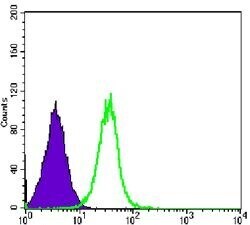
- Experimental details
- Flow cytometric analysis of HeLa cells using GSK3B monoclonal antibody (Product # MA5-15597) (green) and negative control (purple).
- Submitted by
- Invitrogen Antibodies (provider)
- Main image
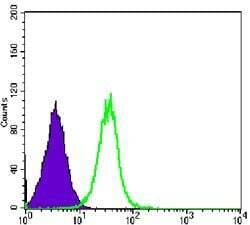
- Experimental details
- Flow cytometric analysis of HeLa cells using GSK3B monoclonal antibody (Product # MA5-15597) (green) and negative control (purple).
Supportive validation
- Submitted by
- Invitrogen Antibodies (provider)
- Main image
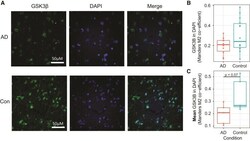
- Experimental details
- Immunohistochemistry of angular gyrus sections with anti-GSK3beta shows a trend towards increased nuclear GSK3beta in controls . ( A ) Representative images show increased colocalization of GSK3beta signal with nuclear DAPI staining. Subjective visual analysis suggests increased presence of nuclear speckles in Control samples compared with AD. ( B ) Plot showing Mander's M2 overlap coefficient for each individual image shows an enrichment for increased nuclear overlap of GSK3beta staining with DAPI. ( C ) The mean Mander's M2 coefficient for each subject shows a trend (Student's t -test, T = -2.18, P = 0.07) towards increased nuclear overlap of GSK3beta in controls compared with AD.
 Explore
Explore Validate
Validate Learn
Learn Western blot
Western blot ELISA
ELISA Immunocytochemistry
Immunocytochemistry